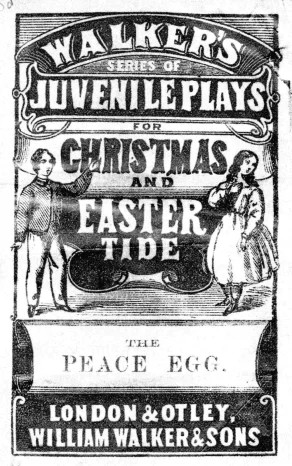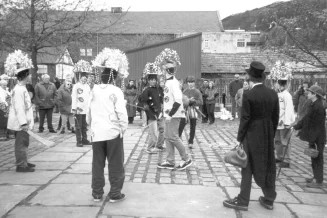Michael Haslam muses on the Easter mumming play, to make an important observation concerning its age
It’s done because it’s done
This much, I believe, is agreed: Pace-Egg, a variant of the St. George Play, is a Folk Play and a Calendar Custom. It was once widely distributed across Britain. Two of its most celebrated examples are enacted, today, in the Upper Calder Valley of West Yorkshire on Good Friday. To say more than this is to venture onto debatable ground.
Studies have focused on matters of function and origin, with wildly different results, from Pace-Egg as a ‘savage survival’, a pagan, pre-Christian fertility ritual to, more recently, Pace-Egg as a largely 19th-century ‘wealth-transfer’, in which workers beg a little back off the boss-class, to tide them over, and perhaps make more festive, a religious holiday. The older view, which still has power to annoy social historians, is in retreat. It has been beaten off the field. I don’t come, like The Doctor, to try to revive it. I want to treat Pace-Egg as a poem, a dramatic poem that has to be part of literary history, or more specifically A History of English Doggerel. And here’s a problem: we cannot, positively, put a date to the Pace-Egg Play.

What’s a ‘folk play’; what’s a ‘calendar custom’? A minimal definition of folk arts might be that they are arts, often anonymous, that have been considered unworthy of the attention of a more learned tradition. There have been times, though, in the history of poetry at least, when the learned tradition has sought to energise itself through attention to low-life forms, and these, for me, have been the most vibrant literary periods: in shorthand, late-Renaissance, Romantic, Early Modernist. But for the most part, folk arts have been grouped with folklore, superstitions, quaint beliefs, and handed to the curious dilettantes and antiquarians, and their successors, the social scientists and accredited historians.
My minimal definition of ‘calendar customs’ would be that (like the soldier’s lament, ‘we’re here because we’re here…’) they are things that people do because they do, because they do them at certain fixed times of year. The Christian Year (like the Judaic and Islamic Years) is made up of a round of calendar customs, ostensibly related to events in the life of Jesus Christ. There’s nothing wild about a sceptical approach to Christian explanation that would see the ‘real’ or deep-structural reason for calendar customs being the human need to mark, and indeed celebrate, the solar year, for reasons of agriculture and social psychology. What is wilder, and has produced some shaky history, has been a ‘neo-paganism’ that has felt in sore need of the element of worship. And what is there, without God, to worship but Sun, Earth, Moon, Stars, and of course Sex?
There’s some contemporary folklore that transpires from this: the idea that Pace-Egg players are ‘really’ Nature-Worshippers, and this is what horrifies evangelical Christians and annoys social scientists. My own view is that much of what clusters on this field forms a sort of disembodied or deterritorialised poetic image, playing in an area of interpersonal and fluid imagination. Poets have always drawn on it. Others want to pin its features to matters of interpretation and belief. It’s hard to put dates to the features of fluid imagination.

If it’s hard to date matters of imagination (St. George may pop up at any time in the past thousand years, or more) we are on surer ground in matters of poetic rhythm, of cadence. In the learned tradition, individuals aware of the past will, consciously or not, break ground and introduce novelty. Scholarly experts can generally date a piece of verse to within, say, twenty or thirty years. It’s more difficult in an oral, anonymous folk tradition, where cadence is perhaps the most conservative feature because the matter is remembered by cadence. We can sometimes determine more or less when it is that a certain cadence first appears. We might be able to place Pace-Egg in a history of English doggerel. But first, I want to go back to that ‘pagan’ floor.
Pointing the finger
Who was to blame for the modern folklore that Pace-Egg is a pre-Christian fertility ritual? I think I have been to the scene of the crime.
The Faculties of Archaeology and Anthropology, and of English Literature at Cambridge University were both offshoots of the traditional study of Greek and Latin. Arch. & Anth. sought to uncover the depths beneath the extant texts. Sir James Frazer’s great work can be seen as a 12-volume exegesis of a few lines of Virgil. In Dryden’s (late 17th Century) translation:
They winged their flight aloft; then, stooping low
Perched on the double tree that bears the golden bough.
Through the green leaves the glittering shadows glow;
As on the sacred oak, the wintry mistletoe
Frazer believed in Progress (magic-religion-science) and was contemptuous of ‘primitive magic’, but Jane Harrison, who was concerned to debunk a myth of Ancient Greece as a site of light, clarity and rationality, betrays an excited fascination with the barbarities she uncovers. By the 1960s (when I was there, doing Literature), Anthropology had become more sociological, less literary, and Frazer was considered obsolete, discredited and out-of-date. The English Faculty, meanwhile, was still infested with Frazerism.
The study of literature, meanwhile, was having some trouble trying to justify itself to itself. What was it for? Did fine discriminations make us better people with enhanced moral sensibilities, or was that just a ploy to entrench class-distinctions. Perhaps poems were merely an adjunct of history. The discipline was reaching to bolster itself by reaching for other human sciences: philosophy, psychology, anthropology. The richest ground seemed that where literary anthropology and analytical psychology met; where Oedipus slew his father. Literary study was betting its life on obsolescent fads.
Two areas where the modern Myth of The Pagan took root were in the study of medieval literature, and in the practice of 20th Century poetry. The strange world of medieval Christianity seemed, to some scholars, imbued with pagan magic. Some knowledge of the work of the Classical Anthropologists was vital for the understanding of the poetry of, among others, T S Eliot, Robert Graves and Ted Hughes. I was, myself, less interested in theories and explanations than in the discovery of image and the practice of cadence.

Released from the academic world, I saw Pace-Egg for the first time at Easter 1971, and heard the story of its ‘fertility ritual’ origins. Marvellous! It became one of my ‘calendar customs’, a sort of pagan-lite Easter matter, more April, Ale and Daffodils than Crucifixion, or any sort of focus for worship or belief. I mused casually on its cadence and imagery. The characters seemed, mostly, medieval. The versification, I’d have said, was mid-Elizabethan. So I was rather startled when I learned, in the 21st Century, that it was ‘really’ a creation of the industrial 19th Century.
The hidden antiquarian
I encountered this news in Eddie Cass’s books, The Lancashire Pace-Egg Play and The Pace-Egg Plays of the Calder Valley. Just at this time I happened to be reading Thomas Nashe, who, writing lively prose in the 1590s, seemed to make clear reference to the dramatic figures of St. George, The Black Prince, The Turk (for The King of Egypt), The Fool and Tosspot. I took this as evidence that Pace-Egg had, at least, a 16th Century origin. I communicated my doubts to John Billingsley, he forwarded them to Eddie Cass, and I had the courtesy of a reply. I should have known better. If I’d read Cass more carefully I’d have seen that he had my point well covered. Yes, the characters were part of popular culture and may have had medieval origins, and yes, crude drama was part of popular culture, but the plot of the play probably derives from the (prose) chapter III of Richard Johnson’s ‘The Seven Champions of Christendom’ (1596), or subsequent chap-books, and the proof that this tale did not take dramatic form before the 18th Century is that there’s no evidence that it did so: absence of evidence as proof of absence. Here’s Cass’s case put most bluntly (pers. comm.): “The origins of mumming plays have been extensively analysed since the early 1970s by the linguists, historians, folklorists, Elizabethan literary scholars associated with the Traditional Drama Research Group and we all agree that the play cannot be any older than the first half of the 18th century”.
So there we have it. The road to the past is barred in the Turnpike Age. I can’t argue with that host. Pace-Egg is an 18th-century poem. I think that’s rather exciting news for 18th-century poetry, whose learned forms tend to either dullness (you could fall asleep on Cowper’s ‘The Sofa’) or, as satires, limited historical interest. A poem redolent of 16th-century rubbish can become a gem of 18th-century doggerel.
There was another piece of ‘evidence’ that I’d provided in my forwarded email: lines from Ben Jonson’s ‘Bartholmew Fair’(1614). Captain Whit bursts in spouting some ridiculous antique nonsense:
Behold, man and see, what a worthy man am ee!
With the fury of my sword, and the shaking of my beard
I will make ten thousand men afeard
and I added the editor’s note ‘Whit’s lines smack of the traditional St. George Play’. To this, Cass replied that this is ‘merely an unsupported editorial gloss’. Here I differ. ‘Smacks’ surely means no more than redolence, aroma, and the gloss is adequately supported by ear. No proof, I admit, for an early date for Pace-Egg, but illuminating for a history of dramatic doggerel.
What is the Pace-Egg metre? Well, it’s doggerel in its irregularity, and mainly iambic, in rhyming couplets of between six and sixteen syllables. But, to my ear, the basic melodic shape is that of the mid-Elizabethan ‘fourteener’. Consider these lines (here ‘Hector’ is merely a device for randomness):
I am a valiant soldier, and Hector is my name.
Many bloody battles have I fought, and always won the same.
[Pace-Egg, 1935 transcription]
But like a wretch he ran away when Hector came with fire,
Which I, defending, from these ships did force him to retire
[Arthur Golding, translating Ovid (1565)]
And Hector spake to the hostes, ‘Troyans! and hardie Greekes!
Heare now what he that stird these warres for their cessation seekes
[George Chapman, translating Homer (1611)]
— Are you that knight of the Golden Shield of whom such faith doth go?
— I am that selfsame knight, fair dame, as here my shield doth show.
[dialogue in George Peele’s play ‘Sir Clyamon and Sir Clamydes’ (1580s)]
The fourteener, a learned metre of the mid-16th century, in its strictest form goes thus:
tiTum tiTum tiTum tiTum; tiTumtiTumtiTum
As such, it’s clearly related to ballad metre (border rather than broadside), but meant for recitation rather than song, and not enclosed in quatrains. It is ridiculed as old-fashioned or plebeian by Shakespeare’s generation (Quince, in ‘A Midsummer Night’s Dream’ considers doing ‘Pyramus and Thisbe’ in ‘eight and six’). It is dead as a learned metre after Chapman. It lives on as comic folk-doggerel picks up on the sing-song qualities that make it unsuitable for high eloquence or low realism. It survives, or is revived, in the Pace-Egg Play.
By whom? I think there must have been an author, possibly a rustic, inheritor of an oral tradition. Or, just possibly, it’s the work of some anonymous 18th-century antiquarian, aware of old image and old cadence. As such it belongs somewhere between Percy’s ‘Reliques’ (1765), that revived a moribund ballad tradition, and the hoaxes or half-hoaxes of Chatterton’s Rowley poems (1760s) and Macpherson’s Ossian (also 1765).
Whatever its origin, it catches fire and spreads in the 19th century. And what would have been an insignificant 16th-century trumpery is revealed as an important Romantic precursor, an outstanding 18th-century poem by some hidden antiquarian. Wonderful! I’m almost Eddie Cass’s convert.
Published in NE121, Spring 2010, pp.12-16